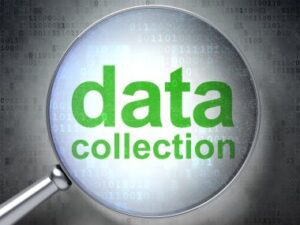What are the best five most common types of data collection?

What are the best five most common types of data collection? It is important to know the 5 types of data collection. These help us improve the results of our company. The value of data has been demonstrated throughout all contemporary endeavors, from academia to commerce. In order to fully understand the processes that the data is collected for, sufficient data must first be collected.
However, there are particular channels via which data is gathered. The article will center on the numerous techniques that can be employed to gather data. In addition, the top five approaches that can be used for data collection will be outlined.
There are different instruments to collect information that are used depending on the purpose. The proper design of these instruments is essential to reach reliable and valid conclusions. Below, we will give you some examples of instruments that you can use to collect qualitative or quantitative data for your analysis.
Data collection
Data collection is a systematic process of gathering observations or measurements. Whether you are performing research for business, governmental or academic purposes, data collection allows you to gain first-hand knowledge and original insights into your research problem.
While methods and aims may differ between fields, the overall process of data collection remansi largely the same. Before you begin collecting data, you need to consider:
- The aim of the research
- The type of data that you will collect
- The methods and procedures you will use to collect, store, and process the data
To collect high-quality data that is relevant to your purposes, follow these four steps.
Examples of instruments to collect information
Data collection is an important step in the research process. The instrument you choose to collect data will depend on the types of data you plan to collect (qualitative or quantitative) and how you plan to collect it.

Step 1: Define the aim of your research
Before you start the process of data collection, you need to identify exactly what you want to achieve. You can start by writing a problem statement: what is the practical or scientific issue that you want to address and why does it matter?
Next, formulate one or more research questions that precisely define what you want to find out. Depending on your research questions, you might need to collect quantitative or qualitative data:
- Quantitative data is expressed in numbers and graphs and is analyzed through statistical methods.
- Qualitative data is expressed in words and analyzed through interpretations and categorizations.
If your aim is to test a hypothesis, measure something precisely, or gain large-scale statistical insights, collect quantitative data. If your aim is to explore ideas, understand experiences, or gain detailed insights into a specific context, collect qualitative data. If you have several aims, you can use a mixed methods approach that collects both types of data.
- Your first aim is to assess whether there are significant differences in perceptions of managers across different departments and office locations.
- Your second aim is to gather meaningful feedback from employees to explore new ideas for how managers can improve.
You decide to use a mixed-methods approach to collect both quantitative and qualitative data.
Several instruments are used in the research to collect information:
- Interviews
- Observations
- Archival documents and government sources
- Laboratory experiments
Paper questionnaire or online questionnaires - In-person focus groups or online focus groups
- Online communities
- Let’s look in more detail at three of the instruments for collecting information that are considered the most used.
Questionnaires
The questionnaire is a tool designed for the collection of quantitative data, and is widely used in research, as it is a good research instrument for collecting standardized data and making generalizations.
Questionnaires can provide quick answers, but care must be taken when developing them to ensure that the response received is not influenced. The design of the questionnaire should reflect the objectives of the research.
Interviews
Interviews are primarily a tool for collecting qualitative data and are popular as information gathering instruments due to their flexibility. The interactions generated in an interview can be presented in a structured or semi-structured way to generate ideas and concepts.
When planning and considering an interview, the following factors are taken into account:
- Completeness
- Touch
- Precision
- Accuracy
- Confidentiality
Interviews require specialized skills on the part of the interviewer, who will need to have a good relationship with the interviewee to ensure that a very detailed and valid set of qualitative data is actually collected and transcribed effectively.
There are different types of interviews:
- Individual, face-to-face verbal exchange
- Face-to-face group interviews (discussion groups)
- Telephone surveys
Interviews can be:
- Made in one go
- Conducted as multiple, longer sessions
- Structured, semi-structured, unstructured interviews

Observation
Observation is another instrument for collecting information that consists of observing individuals in their natural environment or in a situation that occurs naturally.
The processes observed are normal. They can range from individual cases to entire groups and communities. Data collection is laborious and time-consuming and may have to be repeated to ensure reliability. However, observation programs based on a set of expectations can facilitate data collection.
The observer’s level of participation can vary from participant to non-participant. The non-participant observer has limited interaction with the people observed.
Observers can collect data through field notes, video or audio recordings, which can be analyzed using qualitative analysis tools. If observations are coded to obtain exact numerical data, they can be analyzed using a quantitative approach. One of the main advantages of using an observation is that it can lead to a good relationship with the participants, which encourages them to speak freely. This contributes to the richness of detail in the data collected.
Focus groups
The focus group method is a qualitative method of data collection. This is a group interview technique, moderated neutral, whose objective is to collect information on a limited number of predefined questions.
Conducting focus groups requires respect for certain methodological standards to guarantee validity and scientific character. It is one of the instruments for collecting information that allows exploring and stimulating different points of view, thanks to the meeting of various personalities that favor the expression and debate of opinions.
Online communities
Online communities are a promising object of study for marketing. Creating links between individuals and seeking social interactions are greatly facilitated by the Internet. The study of these communities is seen from an essentially qualitative angle, ranging from content analysis of virtual discussion groups to ethnography or ethnography applied to the Internet.
Online communities are one of the most complete instruments for collecting information, since in the same space you can do surveys or polls, such as focus groups, have an idea generation board, reward participants for their feedback, and more.
Various Data Collection Methods
Primary data collection and secondary data collection are the two broad categories into which many data-gathering techniques can be placed. Primarily, we can categorize the ways in which we gather information into two broad categories: qualitative and quantitative.
Qualitative data collection methods
The emphasis in this form of data gathering is on the quality of the data collected rather than on the quantity. Researchers often rely on their gut feelings or other unstructured sources of information while collecting this type of data.
While researchers or users can always adjust their approach, gathering qualitative data takes a significant amount of effort. Research requires meticulous documentation in the form of notes, photographs, audio recordings, or any other medium deemed appropriate by the researcher. Interviews, document reviews, online questionnaires, web surveys, discussions, and observations are all examples of common qualitative methods of data collection.
Quantitative data collection method
Quantitative research relies more heavily on quantity than quality, as suggested by the name of the methodology. Data derivation typically entails some sort of mathematical calculation. Interviews (in-person, over the phone, and via computer-assisted personal interviewing [CAPI]) and questionnaires (in both electronic and paper-and-pencil formats) are all part of the quantitative approach to data collecting.
5 Methods of Data Collection
There are several reported approaches to data collection. Some of the most common methods of data collection in the present day are as follows:
1. Surveys
Among the many methods of gathering information, customer surveys present an opportunity to directly query clients for their thoughts and opinions. Surveys are a useful tool for gathering both qualitative and quantitative information. Typically, they take the form of a list of questions or concerns about a given service or item. Typically presented as multiple-choice inquiries, or occasionally requiring an explanation in a few words, these inquiries require responses from the customers. Study questionnaires can be administered over the internet, paper, and pencil, or over the phone. However, surveying in an online format is the most convenient. The poll can be created and the link shared via email, social media, or any number of other channels.
2. Keeping an eye on the social media landscape
Many people these days utilize social media to document their daily activities online. This is one of the advantages of modern technology, especially given the internet’s central role in disseminating knowledge. Social media is also useful for another purpose: gathering feedback from customers.
Researchers can learn about customer preferences by perusing the lists of people who are already using or interested in a particular product or brand. It’s important to know who you’re selling to before you can create a successful product. People who are passionate about a certain brand are more likely to mention it in their profiles. By frequently looking for brand names, you can learn what kinds of consumers are buying your products. There are also several resources available to help make the most of analytics from outside sources.
3. Online monitoring
Owning an app or website can provide a wealth of information on customers for a company or organization. The acquisition of client information will be greatly aided by the technological tools available today. Customers contribute data points even if they just visit a single page. Data analysis reveals useful information about the website’s popularity and the number of people who have visited it. In addition to this, data about which tabs visitors opened and for how long they stayed on the site is also recorded. Collecting this data and analyzing it with the right analytics program is possible.
4. Marketing Analytics
Businesses rely on marketing campaigns to spread the word about all of the products they’ve created. Despite marketing efforts, it has been noted that a great deal of data may be gathered from any website, email, or another online medium. With the right ad placement software, you can track which consumers or viewers clicked on your marketing ads. Information about the customer’s viewing time and device is also sent.
5. Registration and subscription data
When a customer joins an organization’s email list, the company learns certain details about that person. The next step is to collect data from clients, which will be utilized to send them the information they care about.
